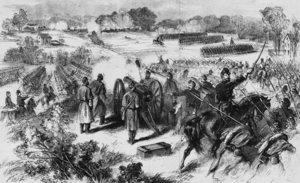Battle of Dranesville
| Battle of Dranesville | |||||||
|---|---|---|---|---|---|---|---|
| Part of the American Civil War | |||||||
 Battle of Dranesville |
|||||||
|
|||||||
| Belligerents | |||||||
|
|
|
||||||
| Commanders and leaders | |||||||
| Edward O. C. Ord | J. E. B. Stuart | ||||||
| Strength | |||||||
| 5,000 | 4,000 | ||||||
| Casualties and losses | |||||||
| 71 | 230 | ||||||
Coordinates: 38°59′43.7″N 77°20′13.9″W / 38.995472°N 77.337194°W
The Battle of Dranesville was a small battle during the American Civil War that took place between Confederate forces under Brigadier General J. E. B. Stuart and Union forces under Brigadier General Edward O. C. Ord on December 20, 1861, in Fairfax County, Virginia, as part of Major General George B. McClellan's operations in northern Virginia. The two forces on similar winter-time patrols encountered and engaged one another in the crossroads village of Dranesville. The battle resulted in a Union victory.
Following the Battle of Ball's Bluff on October 21, major offensive action was halted in the eastern theater, as both armies went into winter quarters. Small detachments were still occasionally sent out to probe the enemy's position and to obtain forage. Such was the case early on the morning of December 20 when General Stuart, with a mixed brigade of infantry comprising the regiments of the 6th South Carolina, 1st Kentucky, 10th Alabama, and 11th Virginia, 150 of his cavalry troopers and Allen S. Cutts's four-gun Georgia battery, set out north from their position near Centreville to escort the army's wagons trains on a foraging expedition into Loudoun County. Meanwhile, General Ord, leading the 10,000 strong 3rd Brigade of Pennsylvania Reserves set out west from Langley to clear the south bank of the Potomac River of Confederate pickets and partisans in Fairfax and Loudoun. At Colvin Run Mill, Ord left half his force to protect his rear and prevent his force from being cut off from their base at Langley.
...
Wikipedia
